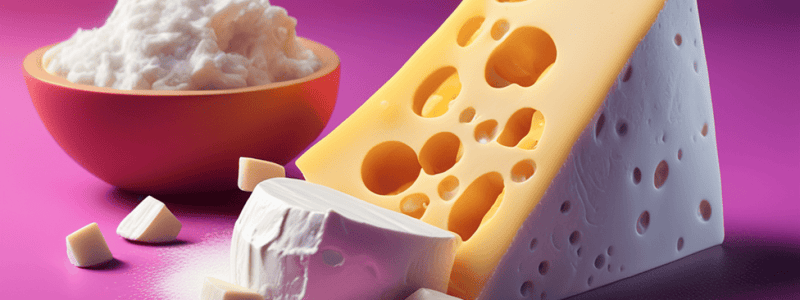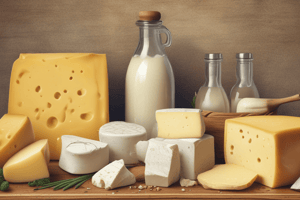Podcast
Questions and Answers
Which type of cheese is typically used in salads?
Which type of cheese is typically used in salads?
- Brie
- Camembert
- Feta (correct)
- Stilton
What is a common use of Halloumi cheese?
What is a common use of Halloumi cheese?
- Quiches
- Cheeseboards
- Burger topping (correct)
- Pizza
Which type of cheese is commonly used in cheesecakes and filled ravioli?
Which type of cheese is commonly used in cheesecakes and filled ravioli?
- Feta
- Edam
- Cheddar
- Ricotta (correct)
What sets Blue Cheese apart from other types of cheese?
What sets Blue Cheese apart from other types of cheese?
What happens to the texture of cheese when exposed to too much heat?
What happens to the texture of cheese when exposed to too much heat?
How should cheese be stored to prevent drying out and cross-contamination?
How should cheese be stored to prevent drying out and cross-contamination?
How does cooking cheese affect its digestibility?
How does cooking cheese affect its digestibility?
What is the recommended temperature for storing cheese in the fridge?
What is the recommended temperature for storing cheese in the fridge?
What primarily determines the appearance, colour, flavour, and texture of the final cheese?
What primarily determines the appearance, colour, flavour, and texture of the final cheese?
Why are women advised to avoid consuming soft cheeses like brie and camembert during pregnancy?
Why are women advised to avoid consuming soft cheeses like brie and camembert during pregnancy?
What impact does the storage duration have on the flavour of cheese?
What impact does the storage duration have on the flavour of cheese?
Why is milk classified as a ‘complete’ food for newborn mammals?
Why is milk classified as a ‘complete’ food for newborn mammals?
What is the primary reason humans continue to include milk in their diets even after infancy?
What is the primary reason humans continue to include milk in their diets even after infancy?
Why does skimmed milk have fewer calories compared to whole milk?
Why does skimmed milk have fewer calories compared to whole milk?
What is the purpose of pasteurisation in the milk processing industry?
What is the purpose of pasteurisation in the milk processing industry?
Why is it against the law to sell unpasteurised or 'raw' milk without a special license?
Why is it against the law to sell unpasteurised or 'raw' milk without a special license?
Why is evaporated milk known to have a slightly caramel flavor?
Why is evaporated milk known to have a slightly caramel flavor?
What is the purpose of homogenisation after pasteurisation in milk processing?
What is the purpose of homogenisation after pasteurisation in milk processing?
How does ultra heat treated (UHT) milk differ from pasteurised milk?
How does ultra heat treated (UHT) milk differ from pasteurised milk?
Which type of processed milk is created by heating fresh milk to about 135 °C for 1–2 seconds before packaging?
Which type of processed milk is created by heating fresh milk to about 135 °C for 1–2 seconds before packaging?
What is one reason why some people opt for milk alternatives like soya, rice, almond, or oat milks?
What is one reason why some people opt for milk alternatives like soya, rice, almond, or oat milks?
Which milk alternative typically contains the most calories per 100 ml?
Which milk alternative typically contains the most calories per 100 ml?
How do the fat content of alternative milks typically compare to fresh cow's milk?
How do the fat content of alternative milks typically compare to fresh cow's milk?
Which nutrient is typically higher in cow's milk compared to most milk alternatives?
Which nutrient is typically higher in cow's milk compared to most milk alternatives?
What is the primary function of cream in enhancing sauces?
What is the primary function of cream in enhancing sauces?
Which type of cream is commonly used for whipping purposes?
Which type of cream is commonly used for whipping purposes?
What distinguishes Clotted Cream from Soured Cream?
What distinguishes Clotted Cream from Soured Cream?
Which type of cream is traditionally enjoyed with scones and jam?
Which type of cream is traditionally enjoyed with scones and jam?
Which type of cream serves as the rich and creamy base for homemade ice cream?
Which type of cream serves as the rich and creamy base for homemade ice cream?
What is a distinguishing characteristic of Greek yogurt compared to regular yogurt?
What is a distinguishing characteristic of Greek yogurt compared to regular yogurt?
Why should cream be consumed only occasionally?
Why should cream be consumed only occasionally?
What is the recommended storage temperature range for both yogurt and cream?
What is the recommended storage temperature range for both yogurt and cream?
Which cream has the highest fat percentage of all creams?
Which cream has the highest fat percentage of all creams?
What is the first step in the process of making yogurt?
What is the first step in the process of making yogurt?
What is the role of lactic acid in the yogurt-making process?
What is the role of lactic acid in the yogurt-making process?
Which of the following is NOT a common use of yogurt in cooking?
Which of the following is NOT a common use of yogurt in cooking?
What is a key benefit of using yogurt in cooking compared to mayonnaise?
What is a key benefit of using yogurt in cooking compared to mayonnaise?
Which of these micronutrients would you NOT find in yogurt?
Which of these micronutrients would you NOT find in yogurt?
During the fermentation process, what happens to the protein content?
During the fermentation process, what happens to the protein content?
Which of these sensory characteristics would you NOT expect a bio yogurt to have?
Which of these sensory characteristics would you NOT expect a bio yogurt to have?
Flashcards are hidden until you start studying
Study Notes
- Cheese is made from coagulated milk proteins and fats, with higher quantities of nutrients compared to milk due to reduced water content.
- Cheese is high in protein, calcium, fat, vitamins A and D, some B vitamins, phosphorus, and zinc.
- Different types of cheese (fresh, soft, semi-hard, hard, blue) have varying fat content per 100g and are used in different dishes.
- Soft cheeses like brie, feta, and camembert can be contaminated with listeria monocytogens, which is harmful especially for pregnant women.
- Cheese should be stored wrapped in a fridge at 5°C to prevent drying out and cross-contamination, with softer cheeses having a shorter shelf life.
- Cheese can be consumed in various ways such as on crackers, in sandwiches, salads, or melted into dishes like pizza and soups.
- When heated, cheese melts at 65°C and can become stringy or spreadable, but too much heat can make it bitter and tough.
Studying That Suits You
Use AI to generate personalized quizzes and flashcards to suit your learning preferences.




